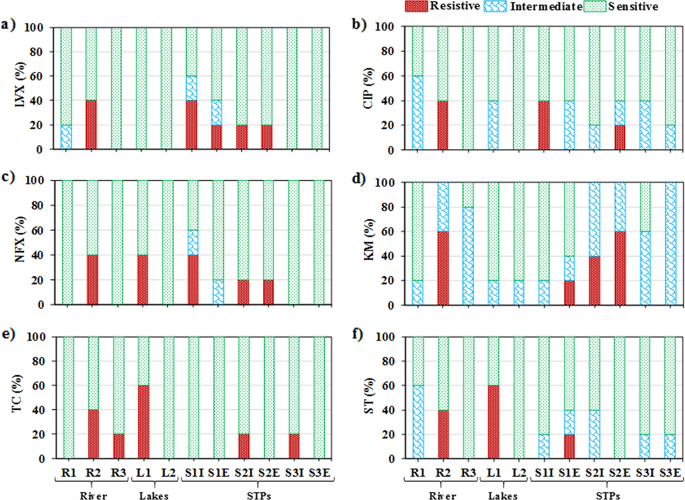npj Clean Water ( IF 10.4 ) Pub Date : 2020-02-04 , DOI: 10.1038/s41545-020-0050-1 Bhagwana Ram , Manish Kumar

|
The present study compares the prevalence of antibiotic-resistant bacteria (ARB) in the urban water of Ahmedabad (India), to understand the correlation of ARB with the fecal, metal, and microplastic contamination. Eleven samples, i.e., three locations of Sabarmati River along with one sample each from two (Chandola and Kankaria) lakes, and influents and effluents from three Sewage Treatment Plants (STPs) were analyzed in this study. E. coli isolated from the samples were subjected to three fluoroquinolones (Levofloxacin (LVX), Ciprofloxacin (CIP), and Norfloxacin (NFX)) and three non-fluoroquinolones (Kanamycin Monosulphate (KM), Tetracycline (TC), and Sulfamethoxazole (ST)) antibiotics for resistance quantification. Prevalence of the E. coli in the Sabarmati River (19,467–76,600 cfu mL−1) was higher than the lakes and STP(s), except the influent sample at Juhapura STP. Among the lake samples, Kankaria Lake (KL) exhibited 0% resistance towards all six antibiotics despite 5× prevalence of E. coli than that of Chandola Lake (CL) exhibiting up to 60% resistance for non-fluoroquinolones and 40% resistance to NFX. Multivariate statistical analyses suggest that resistance for ST, KM, and TC is more prevalent and correlated with electrical conductivity (EC), finer size microplastic, manganese (Mn), and nickel (Ni), whereas the resistance for fluoroquinolones (LVX, CIP, and NFX) seems highly influenced by seasonal temperature variation. Larger size microplastic clustered with salinity, ORP, and Pb. Further, fecal contamination and antibiotic resistance seem to be governed by the same source and processes, yet it does not show good correlation except for the river samples. This result may be attributed to the dynamic river–human interface, substantial wastewater discharge into the river, stagnant water flow, and urbanization-related discharge conditions rather than the upstream condition.
中文翻译:

热带印度河流,湖泊和污水中抗生素耐药性与粪便,金属和微塑性污染的相关性评估
本研究比较了印度艾哈迈达巴德(Ahmedabad)(印度)城市水中的抗生素抗性细菌(ARB)的患病率,以了解ARB与粪便,金属和微塑料污染之间的关系。在这项研究中,分析了11个样品,即Sabarmati河的三个位置,以及分别来自两个(钱多拉和坎卡里亚)两个湖泊的一个样品,以及来自三个污水处理厂(STP)的进水和出水。对从样品中分离的大肠杆菌进行三种氟喹诺酮类药物(左氧氟沙星(LVX),环丙沙星(CIP)和诺氟沙星(NFX))和三种非氟喹诺酮类药物(卡那霉素单硫酸盐(KM),四环素(TC)和磺胺甲恶唑(ST ))用于耐药性定量的抗生素。大肠杆菌的流行除Juhapura STP的进水样品外,萨巴马蒂河的水(19,467–76,600 cfu mL -1)高于湖泊和STP。在湖水样本中,尽管大肠杆菌的患病率是大肠杆菌的5倍,但坎卡里亚湖(KL)对所有六种抗生素的耐药率均为0%比Chandola Lake(CL)的非氟喹诺酮类药物耐药性高达60%,对NFX的耐药性高达40%。多变量统计分析表明,对ST,KM和TC的耐药性更为普遍,并且与电导率(EC),更细的微塑性,锰(Mn)和镍(Ni)相关,而对氟喹诺酮类药物(LVX,CIP,和NFX)似乎受到季节性温度变化的高度影响。较大尺寸的微塑料聚集着盐度,ORP和Pb。此外,粪便污染和抗生素耐药性似乎由相同的来源和过程控制,但除河流样本外,没有显示出良好的相关性。该结果可能归因于动态的河水与人机界面,大量废水排入河水,水流停滞,









































 京公网安备 11010802027423号
京公网安备 11010802027423号